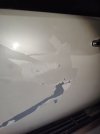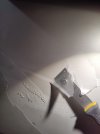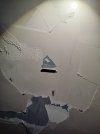Yes, I agree here. It seems like even if you don't overspray enough to cause the paint to start wrinkling (because you sprayed a coat of base with powerful solvents on too thick) it still seems like it can be enough thickness and over spraying to cause a loss of adhesion, and eventually if you keep spraying, you get so much solvent it just completely saturates it and forces the paint to wrinkle. I would guess too that the problem may not actually be that the solvents are present or not it's just that when its sprayed too thick it takes more time to properly flash which would then cause the solvents to get trapped and never leave and it definitely makes sense if things stay in a dissolved state they can never chemically cure. And that would explain why most data sheets say you have to allow for more flash time when spraying more than the recommended number of coats.
With that said, and with a few exceptions like when I was being OCD about wasting paint and just had to finish the extra paint in the cup instead of throwing it away, I feel like I haven't been spraying that thick, although I may have put more coats than recommended, but that was only because I wasn't getting full coverage and could see through to the primer, but then again, maybe I was getting full coverage and maybe the paint (especially the white basecoat) reflects a lot of light back at you which then causes you to see spots.
One thing that's certain here is primer or clear coat and anything that is 2k doesn't have issues it just adheres, anything that is 1k and is a basecoat or the clear base or midcoat causes issues and doesn't adhere. I would also assume since basecoat is just 1k, it is fully dependent on solvent evaporation to do its just so therefore, it must have a lot more powerful solvents than 2k primers and clear coat that require an irreversible mixing with a catalyst to do their job. So like you said these powerful solvents are not your friend and are more of a necessary evil I guess. This also explains why base and midcoat is so enormously expensive because of these powerful solvents and I'm sure EPA regulations make them even extra more expensive.
I find it difficult to really see how much I am spraying and be able to tell while I'm spraying how much coverage I have, and I would think a lot of that is just due to the color I am painting, which could also be even more difficult to tell when I am spraying over sanded clear coat of the same exact basecoat color.
In this instance, because I was scared of wrinkles, I turned the fluid volume was down when spraying the first coat of base, then turned it back to the normal full open on the next coat. When you see most people spray it seems they leave it at full open fluid volume, the adjust with sideways gun speed and/or slight adjustments to spraying distance. I know I do get a lot of runs, and not just clear coat runs, I get basecoat runs, which again probably proves I am spraying way too much and I guess I never just realized it and I always thought my runs were just do to the high temperature I was spraying it (summer heat and sun in a blow up bounce house paint booth is extremely hot, sometimes over 100F).
This also explains why I have gone through so much (probably over $1500 in base and midcoat already) and still haven't gotten to the bed yet.



